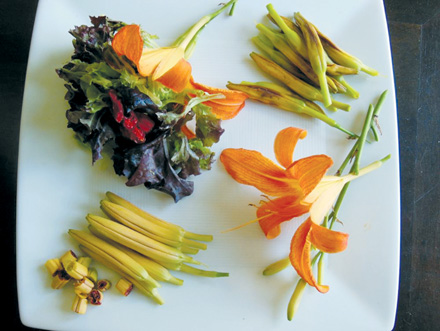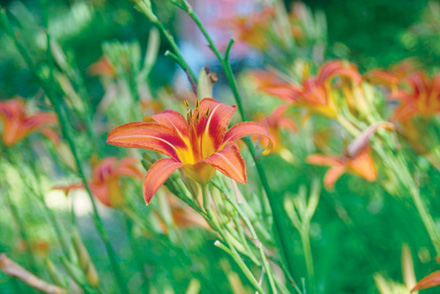Delicious Daylilies

My Washington D.C. friend, Phyllis, likes to have a good chuckle when she stops by on her cross-country trips. She usually cruises through when daylilies are blooming, one of her favorite meal treats. I can’t help but laugh as she uses an English accent to mimic an imagined conversation between a 1621 European immigrant couple as they decide what few critical possession they will take on their trip to the “new world.”
John: “Martha, bees are still in the garden. Has thou remembered to secure them?”
Martha: “Dost thou have room for the flower roots? I have no more space left in my trunk…”
We don’t appreciate them as much today but both bees, and daylilies, were critical to the settlers success.
Hemerocallis fulva, the common orange daylilies, are still prized in European kitchen gardens. When I worked for several weeks in Southampton for the 50th Anniversary of D-Day, several of our English counterparts talked about their tiny gardens. One of the staple plants was daylilies because all parts of the plant are edible.
Not that I initially thought about eating them. I did know they were almost impossible to kill and were wonderful anchors to retain soil so when my husband at the time and I had a house built, we used them to hold in the soil. I was going to say there is little soil on a hillside but that’s not true, there is no soil. We had to bring in soil to fill in around the house.
Besides being garden practical and pretty, I have since learned daylilies are delicious.
Jan Phillips in her book “Wild Edibles of Missouri” calls orange daylilies “another one of mother nature’s grocery stores.” Phillips says the whole plant is edible, from the young flower stalks in spring that taste like asparagus to the tiny, white root bulbs reminiscent of radishes.
Over the years, I have used orange and yellow daylilies for salads and stuffed fare. Salmon and tuna salad inside the washed flowers are a lovely presentation and the entire dish is edible.
I like the flower buds fresh. They are a nice addition to a salad or served on their own as a side dish. They taste like green beans with a hint of onion.
Another way to enjoy the buds is to steam them. It only takes a couple of minutes to make the buds wilt so keep a close eye on them so they are not overcooked.
One of the more popular recipes is to fry. If you want to try, use a flour dip in an egg wash in hot oil for only a minute or so. They cook quickly.
If you are going to eat daylilies, make sure you are picking them from a chemical-free area. Wash in cool water, then allow to dry. When I wash mine, I keep them on their stems in a flower vase with water until I use them.
The flowers only last a day so pick them right before you plan to use.
Charlotte Ekker Wiggins (hyperlink to www.charlotteekkerwiggins.com) is a certified gardener (hyperlink to www.gardeningcharlotte.com) and beekeeper (hyperlink to homesweetbees.com) Copyright 2016 used with permission, all rights reserved. This material may not be published, broadcast, rewritten or redistributed. Contact Charlotte at chargardens@gmail.com.

DAYLILY SMORGASBORD – From left; diced daylily buds; a daylily without filaments and anthers makes a lovely salad wrap; steamed daylily buds and a beautiful cut daylily with buds on stems, all from my garden. (Photos by Charlotte Ekker Wiggins).

DINNER IN A DITCH – Missouri’s ditch lilies have a noble history. Originally from China, they now can be found on most continents and are the basic genetic plant for all of the daylily hybrids now available. The whole plant is also edible.



Facebook Comments